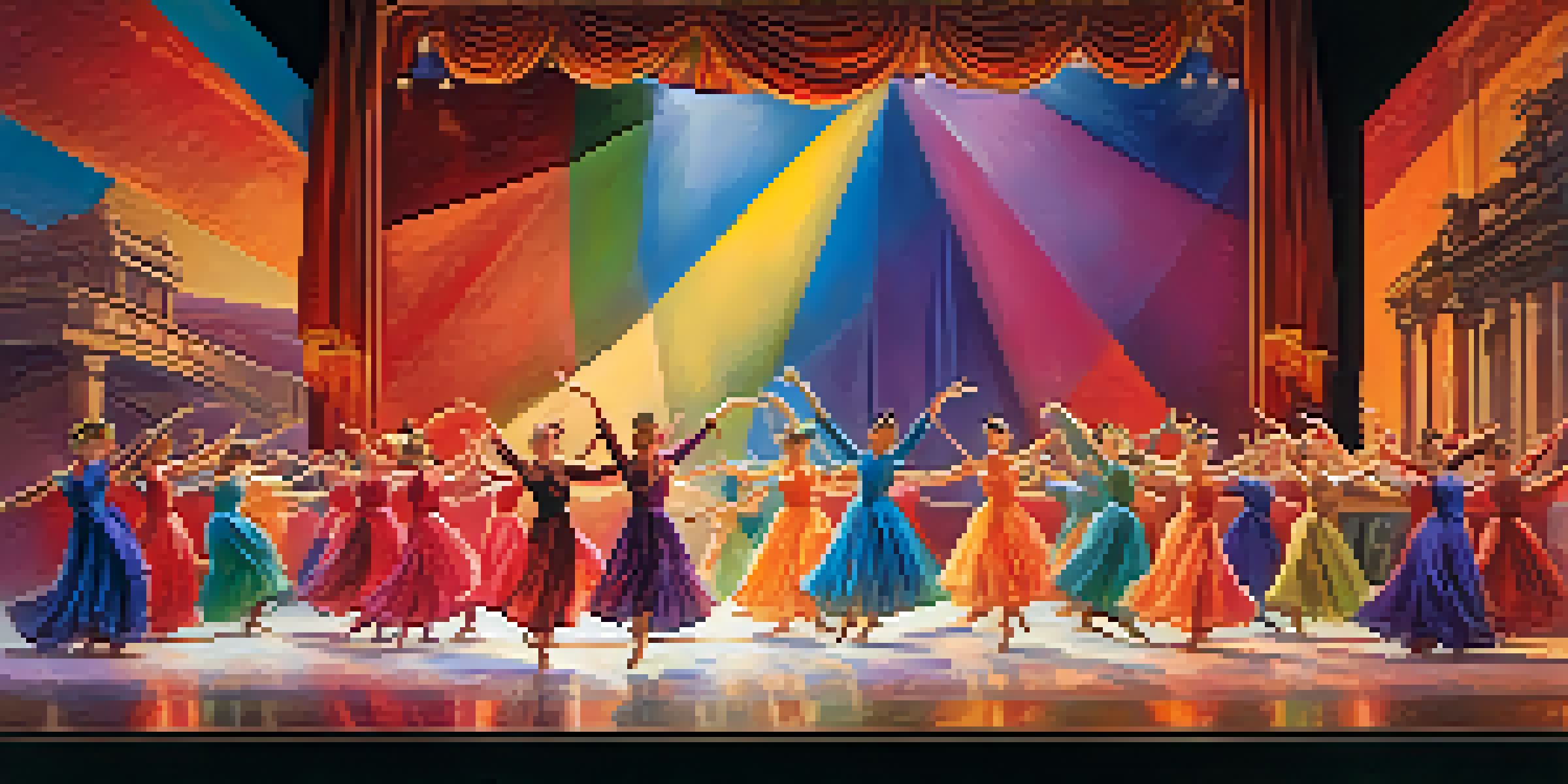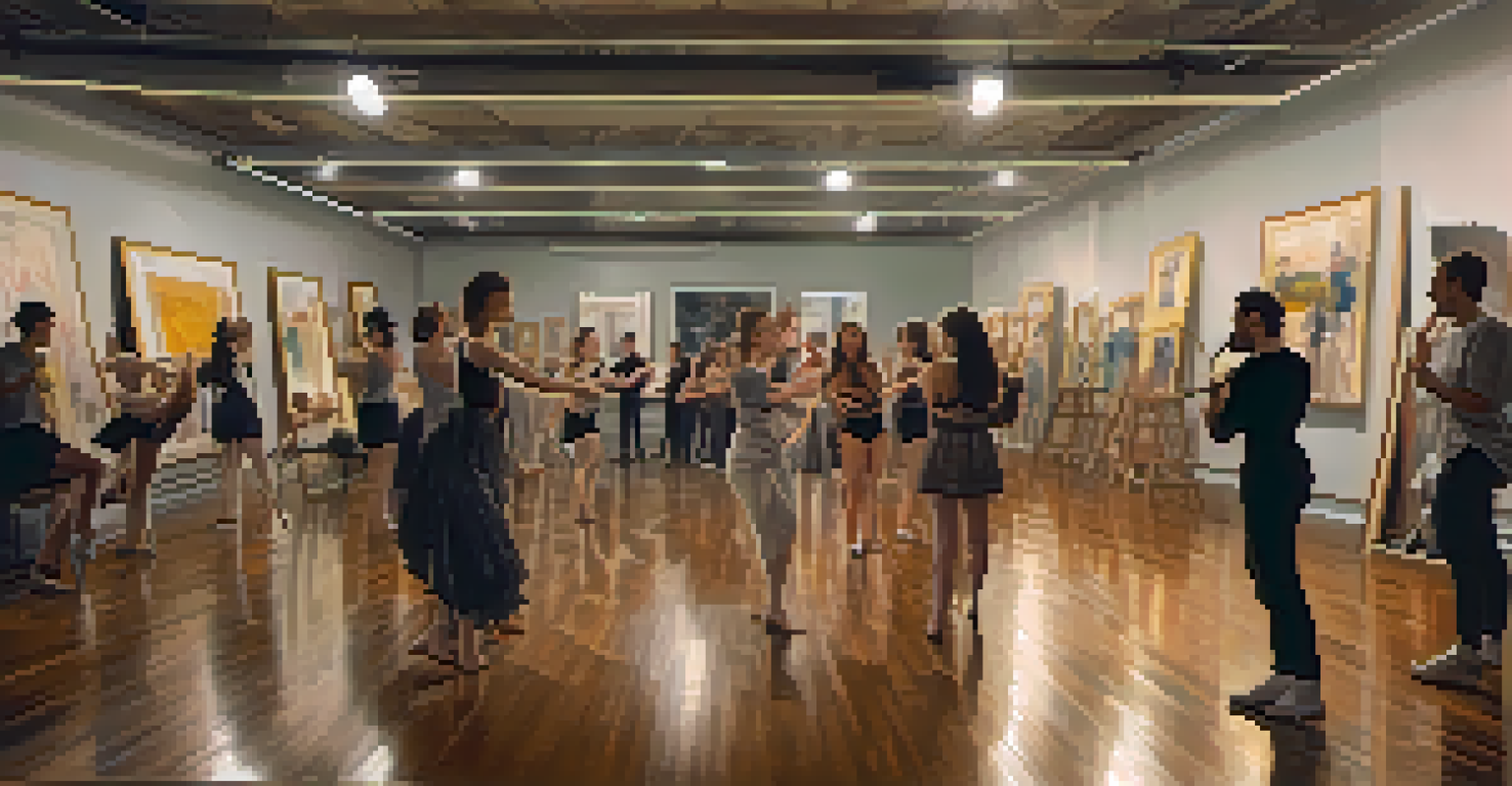Interdisciplinary Approaches: Dance Meets Theatre Collaboration

Understanding Interdisciplinary Collaboration in the Arts
Interdisciplinary collaboration in the arts refers to the blending of different artistic disciplines to create something new and innovative. In our context, this means the fusion of dance and theatre, where movement and dialogue come together to tell a richer story. This approach not only enriches the performance but also broadens the horizons for both artists and audiences alike.
Art is the most beautiful of all lies; it is the most truthful of all truths.
Imagine a dance piece where the physical expression of movement complements a powerful monologue. The audience is treated to a multi-layered experience that engages both visual and auditory senses. This collaboration allows artists to draw from each other's strengths, creating performances that are more dynamic and compelling.
In essence, this synergy creates a dialogue between disciplines, encouraging creativity that transcends traditional boundaries. Artists can experiment, share ideas, and ultimately craft performances that resonate on deeper emotional levels. This is not just collaboration; it’s a celebration of artistic expression.
Historical Context: Dance and Theatre Collaboration
The collaboration between dance and theatre isn’t a new phenomenon; it has roots that stretch back centuries. From the ancient Greek tragedies that incorporated dance to the ballet-dominated theatrical productions of the Renaissance, these two art forms have always influenced each other. However, the modern era has seen a resurgence in these collaborations, with new techniques and technologies allowing for even greater innovation.

For instance, contemporary choreographers often draw inspiration from dramatic narratives, while playwrights explore movement as a form of storytelling. This historical intertwining shows how the evolution of one discipline can spur advancements in another, leading to fresh perspectives and ideas in performance art.
Collaboration Enhances Artistic Expression
Interdisciplinary collaboration in dance and theatre creates dynamic performances that engage both visual and auditory senses.
Thus, understanding this historical context enriches our appreciation of modern works. It highlights the ongoing conversation between dance and theatre, reminding us that innovation often stems from a deep respect for tradition.
The Creative Process: How Artists Collaborate
Collaboration between dancers and theatre artists often begins with a shared vision. This could stem from a script that requires physical interpretation or a choreographer's desire to communicate a story through movement. The initial meetings typically involve brainstorming sessions, where ideas are exchanged freely, fostering an environment of creativity and experimentation.
The arts are not a way of making a living. They are a way of making your soul sing.
As the project progresses, artists must establish clear communication channels. This is crucial in ensuring that both dance and dialogue align harmoniously. Regular rehearsals allow for the refinement of ideas, where improvisation plays a significant role, enabling artists to discover what works best for their performance.
Ultimately, the creative process is a journey of exploration, requiring trust and openness among collaborators. It’s about finding a balance between the two forms, leading to a performance that feels cohesive and unified.
Case Study: Successful Dance and Theatre Collaborations
One notable example of a successful collaboration is the work of choreographer Pina Bausch, known for her groundbreaking productions that seamlessly blend dance and theatrical elements. Her performances often featured dramatic narratives enhanced by powerful movement, captivating audiences worldwide. Bausch’s unique approach showcased how these two disciplines could not only coexist but also elevate each other.
Another example is the acclaimed musical 'Hamilton,' where rap, dance, and historical narrative collide. The choreography complements the storytelling, transforming the stage into a dynamic space where movement and dialogue enhance emotional depth. This production exemplifies how interdisciplinary work can reach a diverse audience, breaking traditional barriers.
Historical Roots Inspire Modern Works
The long-standing relationship between dance and theatre enriches contemporary performances, reminding us of the tradition behind innovation.
These case studies illustrate the potential of dance-theatre collaborations to create innovative and impactful performances. They serve as a reminder of the endless possibilities that arise when artists from different disciplines come together.
Challenges Faced in Collaborative Projects
Despite the exciting potential of interdisciplinary collaboration, challenges inevitably arise. One significant issue is the differing priorities and processes of dancers and theatre artists. While dancers may focus more on physical expression, theatre artists might prioritize dialogue and narrative structure, leading to tension during the creative process.
Additionally, logistics can pose hurdles, such as scheduling conflicts and differing rehearsal styles. Finding a common ground is essential for collaboration to thrive, which often requires patience and flexibility from all parties involved. It’s crucial to navigate these challenges with open communication to ensure everyone’s voice is heard.
Ultimately, overcoming these obstacles can lead to stronger partnerships and more innovative outcomes. The process of addressing challenges can enrich the collaborative experience, fostering deeper connections and enhancing the final performance.
The Role of Audience in Dance and Theatre Collaboration
The audience plays a pivotal role in the success of dance and theatre collaborations. Their reactions and interpretations can significantly influence the performance, creating a dynamic interaction between artists and spectators. Audience engagement often motivates performers to push boundaries and explore new creative avenues.
Moreover, the emotional responses elicited from combined dance and theatre performances can vary widely. This unpredictability adds a layer of excitement, as artists may find their work resonating in unexpected ways. The shared experience of watching a performance can create a sense of community, fostering connections among viewers.
Challenges Foster Creative Partnerships
Navigating the challenges of collaboration can strengthen partnerships and lead to more innovative and impactful performances.
Ultimately, the audience is not just passive observers; they are active participants in the storytelling process. Their engagement enriches the performance and reinforces the idea that art is a collaborative experience between creators and spectators.
The Future of Interdisciplinary Dance and Theatre
As we look towards the future, the collaboration between dance and theatre is poised to evolve even further. With advancements in technology, artists can explore new mediums and creative tools that enhance their storytelling capabilities. Virtual reality, for instance, opens up exciting possibilities for immersive performances that blend movement and narrative in unprecedented ways.
Furthermore, the increasing acceptance of cross-disciplinary work in the art world encourages artists to experiment boldly. This trend is likely to lead to more unique and innovative performances that challenge traditional formats. Audiences can anticipate a richer variety of experiences as artists continue to push the boundaries of their craft.

In conclusion, the future of interdisciplinary collaboration is bright. As artists from different backgrounds unite, they will undoubtedly create captivating performances that inspire and resonate with diverse audiences.